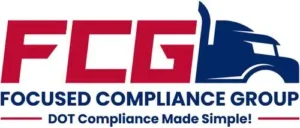The Federal Motor Carrier Safety Administration (FMCSA) is increasing enforcement of English language proficiency requirements for commercial drivers operating in the United States. While this requirement has long been part of federal regulations, recent activity suggests that compliance officers, roadside inspectors, and auditors are being directed to more closely assess whether drivers meet the standard outlined in 49 CFR § 391.11(b)(2).
This renewed scrutiny has real implications for fleets — especially those with drivers who are non-native English speakers or whose English skills were not formally assessed during hiring.
At Focused Compliance Group, we specialize in helping motor carriers stay ahead of evolving DOT regulations. In this post, we’ll break down what’s changing, why enforcement is tightening, and what fleets can do to protect themselves.
Introduction to English Proficiency
English language proficiency is a cornerstone of commercial vehicle safety, directly impacting a driver’s ability to understand highway traffic signs, communicate with law enforcement, and respond effectively in emergency situations. The Commercial Vehicle Safety Alliance (CVSA) has repeatedly highlighted that commercial drivers must be able to read and speak the English language sufficiently to converse with the general public and interpret highway traffic signs. This is not just a regulatory box to check—it’s a critical factor in preventing accidents and ensuring the safety of everyone on the road.
The Department of Transportation, through guidance published in the Federal Register, outlines clear requirements for commercial drivers: they must demonstrate the ability to read, write, and speak English in order to safely operate on America’s highways. These requirements are designed to ensure that drivers can identify and respond to traffic signs, communicate with officials, and complete necessary documentation without confusion.
Research published by Cambridge University Press further underscores the importance of English proficiency in the transportation sector. Studies show that drivers who understand highway traffic signs and can communicate clearly are less likely to be involved in accidents, making English language skills a key component of highway safety. For fleets, ensuring that drivers meet these standards is not only about compliance—it’s about protecting lives and supporting the safe movement of goods across the country.
Understanding the Regulation: What Does the FMCSA Require?
The specific regulation, 49 CFR § 391.11(b)(2), requires that drivers be able to:
- Read and speak the English language sufficiently to:
- Converse with the general public
- Understand highway traffic signs and signals written in English
- Respond to official inquiries
- Make entries on reports and records
- Converse with the general public
- Understand highway traffic signs and signals written in English
- Respond to official inquiries
- Make entries on reports and records
This regulation applies to all CMV drivers operating in interstate commerce, regardless of citizenship or national origin. It’s a critical requirement for ensuring that drivers can respond effectively during emergency situations, communicate during inspections, and interpret route signage — all of which directly impact highway safety.
Why Is FMCSA Focusing on English Proficiency Now?

1. Increased Roadside Inspection Activity
Law enforcement and roadside inspectors are being trained to assess language skills during routine inspections. This means drivers may be asked basic questions to evaluate whether they can communicate effectively in English.
2. Data Quality and Safety Concerns
Inconsistent or incorrect log entries, misunderstandings during inspections, and communication breakdowns with dispatch or emergency responders can all be traced back to language barriers. The use of incorrect words or language in these situations can cause misunderstandings and lead to serious safety issues. These issues impact both road safety and regulatory compliance.
3. Recent Audit Findings
Audits have uncovered fleets employing drivers who do not meet the English proficiency requirements, leading to conditional safety ratings or citations for violations during safety reviews.
4. CSA Score Impact
Violations related to communication during inspections can directly affect CSA BASIC scores, particularly in the Driver Fitness and Unsafe Driving categories.
What Does Enforcement Look Like in Practice?
At this stage, there is no standardized “test” for English proficiency during inspections. However, law enforcement may:
- Ask drivers to describe their trip, destination, or cargo
- Request that drivers read a road sign or phrase aloud
- Instruct drivers to review and explain logbook entries
- Ask questions during Level III inspections to determine if the driver understands and responds appropriately
Failure to demonstrate basic proficiency can lead to out-of-service orders, citations, and recorded violations — all of which have downstream effects on a carrier’s compliance standing.
Common Myths About English Proficiency Enforcement
Let’s dispel a few misconceptions: Enforcement actions typically focus on individual driver compliance rather than company-wide language skills.
Myth 1: “If the driver has a CDL, they’re compliant.”
Not necessarily. While obtaining a CDL requires passing a written exam (often available in multiple languages), FMCSA regulations require English proficiency for ongoing operation — not just licensure.
Myth 2: “As long as someone at the company speaks English, it’s fine.”
No. Each individual driver must meet the requirement independently, regardless of who else is on staff.
Myth 3: “This only applies at the border or in certain states.”
Wrong again. This is a federal regulation enforced across all 50 states and by all authorized inspection agencies.
Legal & Operational Risks for Noncompliance
Noncompliance with English language proficiency standards isn’t just a minor issue — it can have serious legal and business consequences, including:
- Out-of-Service Violations for individual drivers
- Fines and Penalties following inspections or audits
- Increased CSA Scores, which impact insurance rates and DOT safety ratings
- Audit Findings during compliance reviews
- Conditional or Unsatisfactory Safety Ratings, which can lead to loss of business or authority suspension
Real-World Example
A Midwest-based refrigerated carrier recently faced an FMCSA compliance review following a series of roadside inspections. Several drivers were found unable to answer basic questions about their routes and cargo. While no accidents had occurred, the inspector flagged them under the Driver Fitness BASIC. The audit resulted in a conditional safety rating and the company was required to retrain drivers and revise hiring procedures — costing time, resources, and reputation. To resolve the compliance issues identified during the audit, the company implemented corrective actions and closely monitored ongoing adherence to FMCSA regulations.
What Should Fleets Do? A 5-Step Compliance Roadmap
Here’s how your fleet can proactively address English proficiency compliance: Meeting training requirements for drivers is essential to ensure safety and proper conduct, as emphasized by regulatory standards. Additionally, fleets should stay updated on new guidance from the Department of Transportation regarding English proficiency enforcement, as these directives may impact compliance procedures.
1. Update Driver Qualification Files
Include documentation of English proficiency assessments as part of the hiring process. This could be a simple interview checklist or verbal Q&A documented by HR.
2. Incorporate English Proficiency in Orientation
Use onboarding as an opportunity to review signage, communication protocols, and verbal response expectations — all in English, emphasizing the importance of understanding the meanings of these elements to ensure clarity and compliance.
3. Provide Ongoing Language Support
Offer access to online English courses designed for CMV drivers or schedule basic conversation practice sessions. This not only improves compliance — it boosts morale and safety.
4. Prepare for Inspections
Train drivers on what to expect during roadside interactions and how to confidently answer common questions in English. Include this in pre-trip checklists or monthly safety meetings.
5. Conduct Internal Mock Inspections
Just like you test logbook accuracy or pre-trip inspections, include verbal communication as part of your mock DOT inspections.
Putting an End to Non-Compliance
The Department of Transportation is stepping up efforts to eliminate non-compliance with English language proficiency regulations, recognizing the direct link between language skills and highway safety. Through increased enforcement and targeted support for fleets and drivers, the goal is to ensure that every commercial driver is proficient in English and able to understand highway traffic signs.
Technology also plays a role in this compliance landscape. The Cloudflare Ray ID found at the bottom of many compliance-related web pages serves as a unique identifier, helping site owners and administrators quickly address and investigate any issues related to non-compliance or security. Security services and solutions are in place to protect these resources from online attacks, such as SQL commands or malformed data, ensuring that critical compliance information remains accessible and secure.
The administration has reinforced its commitment to highway safety through executive orders and by supporting the Commercial Vehicle Safety Alliance’s decision to reinstate the out-of-service rule for drivers who violate English proficiency requirements. This means that drivers who fail to demonstrate the ability to understand highway traffic signs or communicate in English may be immediately removed from service, underscoring the seriousness of compliance.
Fleets are advised to take advantage of available support and reporting mechanisms to maintain compliance and protect their operations. By prioritizing English language proficiency, the Department of Transportation and the CVSA are working together to create safer highways for drivers and the general public alike.
How Focused Compliance Group Can Help

- Driver Qualification File audits
- Mock DOT audits with English proficiency components
- Policy development and training programs
- Documentation support for internal language assessments
- CSA Score Management & Corrective Action Plans
Our consultants stay on top of FMCSA guidance and enforcement trends so your business doesn’t have to worry about surprises.
Proactive is Better than Reactive
Language proficiency is no longer a “soft” compliance issue. With FMCSA enforcement intensifying, it’s more important than ever to ensure your drivers meet — and can demonstrate — the required level of English fluency.
At Focused Compliance Group, we understand the regulatory landscape and the operational challenges that fleets face every day. We’re here to be your partner in keeping your company safe, compliant, and audit-ready.


